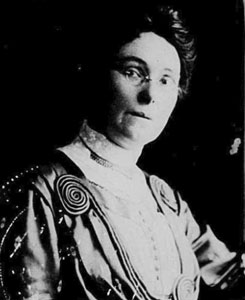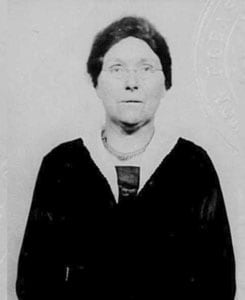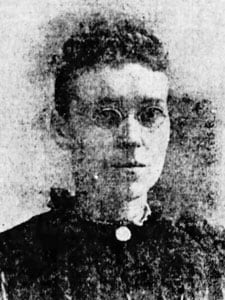Nora Agnes Keane was born in Castleconnell, Co Limerick, Ireland on 30 March 1864.1
She was the daughter of John Keane (1819-1885), a farmer, and Hanorah Fee (1830-1916).
She was sister to: Peter (b. 1857), Albert (b. 1862), Denis (b. 19 December 1867), James (b. 1871), Patrick (b. 1 April 1873) and William (b. 30 September 1875).
Nora emigrated in August 1888 2 when she was still a young woman, aboard the City of Richmond, settling in Harrisburg, Pennsylvania and working as a housekeeper. She was later joined by several of her siblings, her brothers becoming firemen, and she and her brothers later ran the Union Hotel on Paxton Street in Harrisburg. Nora was still an unmarried housekeeper by the time of the 1900 census. Her passports describe her as standing at 5' 9", with fair complexion, brown hair, blue eyes and a broad face.
Nora's father had died on 8 May 1885 with her eldest brother Peter taking over the farm. Her elderly mother continued to live with Peter and his family at house 10, Gardenhill, Castleconnell and Nora had made previous trips back home to visit her family, with one voyage in September 1905 being aboard the Umbria.

Nora boarded the Titanic at Queenstown on 11 April 1912 as a second class passenger (ticket number 226593 which cost £12, 7s). One of only a handful of Irish nationals travelling in second class, it can be assumed that she was acquainted with her fellow countrymen whilst aboard. Her cabin mates were two English women, Edwina Troutt and Susan Webber. Nora would later confess to Miss Troutt that she had a terrible foreboding that the ship may sink, which was compounded when she accidentally dropped her Rosary and prayer book into the ocean whilst boarding.
On the night of the sinking Nora was so nervous that she required help to dress. Despite her anxiety, she insisted that Miss Troutt help her into her corset. Miss Troutt snapped, snatched the corset from her and tossed it away, scolding her about such trifles when they were in danger. The ladies went topside and Nora noted the scene on deck as being quite calm, with the officers having perfect control. She also described how a male "foreigner" jumped into her lifeboat as it was being filled, hiding into the bottom of the boat and being trampled on in the dark. The interloper later proved to be a valuable asset as he helped row.
Nora claimed to have been around 100 yards from the ship when she plunged and was close enough to see people struggling in the water whilst their cries carried across the ocean.
Following her arrival in New York aboard Carpathia, Nora was met by her brothers and she returned to Harrisburg.
Nora, who remained a spinster living in Harrisburg, later ran a public house, living at 167 Paxton Street. Having declared her intention for US citizenship on 31 January 1910, she petitioned for the same on 23 May 1912.
She braved the ocean several times more to visit her native Ireland. With the intention of nursing her sickly mother, on 3 April 1915 Nora set sail on Lusitania, one of that ship's final Atlantic crossings; just over one month later, Lusitania would also be wrecked. The eventual death of her mother on 14 February 1916 saw another voyage back to Ireland.
Nora made another trip back to Ireland in 1919 with the intention of staying there for up to six years before returning back to Harrisburg. However, it is not clear if she ever set foot on American soil again and it seems she remained in Ireland even during the tumultuous period of the Irish War of Independence and the ensuing Irish Civil War.

Living for the remainder of her life in her native Castleconnell, Co Limerick, Nora Keane suffered a fractured hip during the summer of 1944 and complications from that injury led to her death a few months later on 20 December 1944.
Nora is buried in the family grave in Stradbally Cemetery, North County, Limerick, Castleconnell, Ireland (plot L1-STBY-0032).

Photo Courtesy of Trevor Baxter




Comment and discuss
-
I am an actress that will play the role of 2nd class Irish passenger Nora Keane in "Titanic: The Artifact Exhibit" coming to Los Angeles soon. I was wondering if anyone had any extra info on her that is not already included on this webpage, such as was she ever married? Was she courting? Did she have any children? How many brothers did she have? What kind of a shop did she own with her brother in Harrisburg P.A.? Oh, and are there any photos of her? Or any info on her parents or relatives (brothers,sister, etc)? What year was she born? I would appreciate any info available. Thanks, Anna
-
Anna, the book 'The Irish Aboard Titanic' by Senan Molony has a couple of pages on Nora and one photo. She was born in 1866 (but hated to admit it!) and was never married. Her brother owned a hotel in Harrisburg, and Nora later bought a pub in the same town. She eventually returned to Ireland, where she died in 1944. You might try also researching her room-mate Edwina Troutt, who had quite a lot to say about Nora. Bob
-
As an actress, you'll find it useful to know a few pointers towards Nora's character. She seems to have been self-conscious, perhaps rather vain - when she signed up for the Titanic she knocked 11 years off her real age, and in a famous incident she wasted valuable time during the sinking trying to fasten a corset over her nightgown. Certainly she was VERY nervous. When boarding the ship she'd dropped her prayer book and rosary in the water and was convinced this was a bad omen. It didn't help when she was told by another woman passenger that a cock crow was heard at dusk, another portent of doom for travellers. According to Edwina Troutt: "She kept moaning that the ship would never make it to New York, that we were doomed. She drove me a little batty." That should help you to play the authentic Nora. Have fun!
-
Anna, Nora was an interesting character all right. Her actual date of birth was March 30, 1864--born in Castleconnell, County Limerick, Ireland. You might want to contact Senan Molony for more information as he's the ultimate authority on the Irish passengers. Also, if you'll contact me privately at I think I have the email address of one of her great-nieces that still lives in the United States. I'll be out of the country from February 4th thru the 13th but will try to get the address prior to leaving if you'll contact me this weekend. Regards, Phil
-
Phil, I got the 1866 birth date from Senan's book. I reckon Nora is wearing a broad smile in heaven at the thought that even he knocked a couple of years off her age! Bob
-
Hi Bob, Yeah, a lot of those Titanic women stretched their ages. But I found old Norah's birth certificate so have gotten the goods on her :-). In the process of proving the ages of the passengers and crew it seems almost rare that they told the truth. We've even found one woman that stretched it by 17 years! Phil
-
Thanks for all the help! Anna
-
Hi folks Nora Keane was buried in the local graveyard in Castleconnell, Ireland - has anyone got the name of the graveyard or any other info about Nora other than what is readily available on ET Bio - or messageboard. All the best Houghie

-
AN HISTORIC timepiece that stopped ticking when the Titanic sank 93 years ago is to be auctioned (The Irish Independent, April 15, 2005). The 18-carat gold pocket watch is among the rare artifacts connected to the ill-fated ocean liner to be sold by Bonhams and Butterfields in Massachusetts in the US on May 1. The watch, which was damaged when disaster struck mid-Atlantic, belonged to Nora Keane, an Irish immigrant, living in Harrisburg, Pennsylvania with her brothers and sisters. Following a four-month visit to her mother in Castle Connell, Co Limerick, Miss Keane decided to return on the maiden voyage of RMS Titanic, boarding at Queenstown as a second-class passenger. She was rescued by lifeboat with the watch, which was damaged when the lifeboat passed under the ship's pump discharge. Its gilt face has some rust staining, but it is still expected to fetch between €3,800 and €5,300, Bonhams said. The rarest item to be...

-
I realise the above is a very old post, but there seems to be a presumption on the site that "Nora Keane's pocket watch" is legitimate. I'm related to Nora and would just like to mention that the Keane family was pretty astonished by the auction of "her" watch-- as no one in the family in Ireland (or the US) had ever heard of it. Nora certainly would have shown it off to her family. Further, the inscription is very odd with misspelled words and details that seem designed to link it to the sinking of the Titanic. (Why such a wordy inscription from her mother?) I came across this post while looking for a photograph of the Hotel she worked in with her brother Albert Michael in Harrisburg. During the search I also came across an alleged portrait of Nora for sale, stating her link to the Titanic. While the photos of Nora on this site are definitely of her, this pic below (previously for sale) looks absolutely nothing like her. I do hope people carefully check the provenance of Titanic...

-
Do you know when Nora worked in that hotel? Her ET bio suggests the possibility that after returning to her native Ireland in 1919 with an intention of staying for 6 years, she might not have returned to the US at all. There is speculation that she might have got stuck in Ireland due to the...
-
I can’t give a clear answer to your question about why she stayed in Ireland after 1919, but will ask my family if they know more. What I can tell you is that Albert Michael Keane and their sister Mary emigrated to Australia and other brothers emigrated to Harrisburg and lived near each other, all working for the PA Railroad; initially Nora...
-
Slight addendum as I'm not sure I can edit previous post: Nora held the liquor licence at the Union Hotel and applied to transfer it to her brother-in-law Norman Jones in 1917. She traveled back to Ireland in August 1919; not sure if she returned to Harrisburg even though the January 1920 census has her listed as living with Norman Jones. Could be they thought she would return, but she didn't. From 1920 she stayed in Castleconnel, Ireland as you note near her family there.
-
Thank you very much for that. Her ET bio says that when Nora Keane returned to Ireland in 1919, she was planning to stay for 6 years and then presumably return to Harrisburg. But it is possible that by 1925 she was too well settled in the home that her brother built in Casteleconnel and financially secure and so decided to remain. The only thing that surprises me about that is that there was civil war and political instability in Ireland in the 1920s whereas America was at the height of its "Roaring Twenties". Of course, at that time no one knew about the Crash of 1929 and the ensuing Great Depression.
Open Thread Leave a Reply